George L. Teetes, Ph.D., Professor
Department of Entomology
Texas A&M University
College Station, TX 77843-2475

Good day to you who are participating in this electronic lecture.
Recognizing there are entire courses and books on the subject of plant resistance to crop pests, this lecture will cover only the essential aspects of the topic. The role of plant resistance as a direct control tactic in insect integrated pest management (IPM) will be emphasized. Two case studies of the use of insect-resistant varieties as a component of an IPM strategy will be provided.
Ecological Results of Agriculture: In contrast to natural ecosystems, most agricultural crop production systems are ecologically unstable, non-sustainable, and energy dependent. Man has through plant domestication and cultivation practices interfered in many ways with species diversity and natural defense mechanisms of plants. Cultivated crops originated from genetically diverse plant types. However, crop plants are now grown in large, genetically homogeneous stands, a practice that decreases genetic and species diversity and increases the likelihood of economically significant insect pest infestations. Defense mechanisms of plants are re-created in resistant plants. Plant defense mechanisms include escape in space and time, incompatible biological associations, physically and chemically derived barriers, and accommodation by replacement or repair of damaged plant parts. By re-creating plant defenses, genetic resistance to insect pests plays, in an environmentally compatible manner, a vital role in the attempt to enhance ecological stability in agricultural crops.
An IPM Direct Control Tactic: Plant resistance to insects is one of several cultural control methods. Cultural control methods involve use of agronomic practices to reduce insect pest abundance and damage below that which would have occurred if the practice had not been used. In IPM, plant resistance to insects refers to the use of resistant crop varieties to suppress insect pest damage. Plant resistance is intended to be used in conjunction with other direct control tactics.
Definition of an Insect-Resistant Plant: Definitions of an insect-resistant plant are many and varied. In the broadest sense, plant resistance is defined as "the consequence of heritable plant qualities that result in a plant being relatively less damaged than a plant without the qualities." In practical agricultural terms, an insect-resistant crop cultivar is one that yields more than a susceptible cultivar when confronted with insect pest invasion. Resistance of plants is relative and is based on comparison with plants lacking the resistance characters, i.e., susceptible plants.
Effect of Insect Pest-Plant Host Relationship: Insect-resistant crop varieties suppress insect pest abundance or elevate the damage tolerance level of the plants. In other words, insect-resistant plants alter the relationship an insect pest has with its plant host. How the relationship between the insect and plant is affected depends on the kind of resistance, e.g. antibiosis, antixenosis (non-preference), or tolerance.
Antibiosis resistance affects the biology of the insect so pest abundance and subsequent damage is reduced compared to that which would have occurred if the insect was on a susceptible crop variety. Antibiosis resistance often results in increased mortality or reduced longevity and reproduction of the insect.
Antixenosis resistance affects the behavior of an insect pest and usually is expressed as non-preference of the insect for a resistant plant compared with a susceptible plant.
Tolerance is resistance in which a plant is able to withstand or recover from damage caused by insect pest abundance equal to that damaging a plant without resistance characters (susceptible). Tolerance is a plant response to an insect pest. Thus, tolerance resistance differs from antibiosis and antixenosis resistance in how it affects the insect-plant relationship. Antibiosis and antixenosis resistance cause an insect response when the insect attempts to use the resistant plant for food, oviposition, or shelter.
Advantages to the Use of Insect-Resistant Crop Varieties: Use of insect-resistant crop varieties is economically, ecologically, and environmentally advantageous. Economic benefits occur because crop yields are saved from loss to insect pests and money is saved by not applying insecticides that would have been applied to susceptible varieties. In most cases, seed of insect-resistant cultivars costs no more, or little more, than for susceptible cultivars. Ecological and environmental benefits arise from increases in species diversity in the agroecosystem, in part because of reduced use of insecticides. Increases in species diversity increase ecosystem stability which promotes a more sustainable system far less polluted and detrimental to natural resources.
The IPM concept stresses the need to use multiple tactics to maintain insect pest abundance and damage below levels of economic significance. Thus, a major advantage to the use of insect-resistant crop varieties as a component of IPM arises from the ecological compatibility and compatibility with other direct control tactics. Insect-resistant cultivars synergize the effects of natural, biological, and cultural insect pest-suppression tactics. The "built-in" protection of resistant plants from insect pests functions at a very basic level, disrupting the normal association of the insect pest with its host plant. The compatible, complementary role plant resistance to insect pests plays with other direct control tactics is, in theory and practice, in concert with the objectives of IPM. All crop cultivars should contain resistance to insect pests.
Plant resistance to insect pests has advantages over other direct control tactics. For example, plant resistance to insects is compatible with insecticide use, while biological control is not. Plant resistance to insects is not density dependent, whereas biological control is. Plant resistance is specific, only affecting the target pest. Often effects of use of insect-resistant cultivars are cumulative over time. Usually the effectiveness of resistant cultivars is long-lasting.
The role of plant resistance to insects in IPM has been well defined, at least in theory. However, the specific role a resistant cultivar plays in a particular IPM situation is crucial to successful deployment of the resistant cultivar. The impact of the resistant cultivar on standard cultural, biological, and insecticidal control methods should be well defined. Likewise, the impact of each of these control tactics on the resistant cultivar also must be defined.
Several definitions have been used to convey the relative level of resistance in a plant. However, the problem of quantifying resistance continues to be a problem influencing farmer acceptance of insect-resistant cultivars. A better way to define resistance levels in agronomically improved resistant cultivars is through quantified comparisons of insect pest damage or plant yield loss of susceptible cultivars. Once insect pest abundance or damage to yield-loss relationships have been determined, economic threshold levels can be determined and combined with factors such as crop value and insect pest control costs to develop dynamic thresholds for use by producers. Dynamic thresholds provide a description of resistance and can reduce crop loss risk because limitations are known and remedial action can be taken when necessary. By using this system to define relative differences in insect pest resistance between cultivars, it may be possible to simply indicate that a resistant cultivar has a higher economic threshold level than a traditional susceptible cultivar.
Case Studies: Provided here are two examples of the role of insect-resistant cultivars as a component of an IPM strategy. Many other examples could be used.
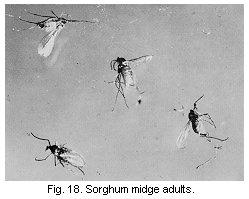
Sorghum midge in sorghum: The sorghum midge, Stenodiplosis sorghicola (Coquillett), is a ubiquitous and serious insect pest of sorghum, Sorghum bicolor (L.) Moench. It is a key insect pest of sorghum throughout the southern production region of the United States. Each ovipositing female sorghum midge lays about 50 eggs between the glumes of flowering spikelets of cultivated sorghum or johnsongrass, Sorghum halepense (L.) Pers. Larval feeding on the developing ovary inside the spikelet prevents normal kernel formation and results in direct grain loss. A single larva is sufficient to destroy a kernel; the entire crop can be destroyed.
A sorghum midge life cycle is completed in 16-18 days under favorable temperatures. This relatively short generation time allows for multiple generations of the insect each season. Sorghum midge abundance can increase each generation when flowering sorghum hosts are available and weather conditions are favorable. Sorghum midges can become especially abundant when successive plantings of the crop allow the flowering period to be extended in a locale.
Johnsongrass is essential for survival of the sorghum midge. In the spring, sorghum midges in an area emerge from overwintering before cultivated sorghum is flowering and lay eggs in flowering spikelets of johnsongrass. Typically, a second generation is produced in johnsongrass before cultivated sorghum in an area is flowering. Sorghum midges disperse to the first flowering fields of cultivated sorghum, and within a single additional generation usually have increased enough in abundance to cause economic damage to sorghum.
Management tactics used to suppress abundance of sorghum midge include pest avoidance by planting sorghum early and uniformly in an area, destruction of johnsongrass, abiotic and biotic natural control involving indigenous parasites and predators, insecticide use, and use of resistant sorghum varieties. The major management tactic is early and uniform planting of sorghum in an area so that sorghum flowers before sorghum midge abundance is high enough to cause economic damage. The nature of sorghum midge biology and characteristics of sorghum panicle flowering make insecticide use less effective and more expensive than desirable.
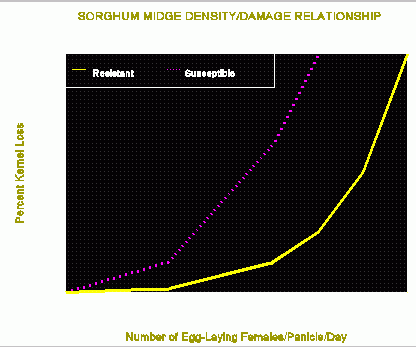
Significant progress has been made in developing sorghum inbred lines that, under high levels of sorghum midge infestation, produce sorghum midge-resistant hybrids with excellent grain yield. This management tactic has received much attention during the past decade. The major resistance mechanism of resistant varieties is non-preference for or interference with adult oviposition caused by differences in spikelet flowering time. Spikelets of resistant sorghum flower during early morning hours before adult female sorghum midges occur in the field. Spikelets of susceptible sorghums flower later in the morning when sorghum midges are present in the field. The consequence of the resistance mechanism is that sorghum midge-resistant hybrids are at least five times less damaged than susceptible hybrids at the same level of sorghum midge abundance.
Consequently, the economic threshold level for sorghum midge-resistant hybrids is five times higher than for susceptible hybrids (Table 1). The elevated economic threshold significantly enhances the effectiveness of other management tactics. In many cases, the resistance level is high enough to prevent economic damage and eliminate the need for insecticides. Also, when sorghum midges become very abundant, insecticide use requirements are much less, and the application(s) is more effective than for sorghum midges infesting susceptible sorghum hybrids.
In this case study, sorghum resistance to sorghum midge plays a fundamental role in the IPM strategy. Resistance is not intended to always provide the sole means of control but is used as a direct control tactic that, in combination with others, provides desired protection of the crop from the insect pest.
Greenbug, Schizaphis graminum (Rondani), in sorghum: This aphid has been an insect pest of small grains in the United States for almost 100 years and a key insect pest of sorghum since the appearance of biotype C greenbugs in 1968. Management approaches to dealing with biotype C after 1968 included using extremely low dosage rates of registered insecticides. Treatment need was based on knowledge of the insect's seasonal abundance trends and economic threshold levels. This IPM approach reduced greenbug abundance below numbers capable of causing economic yield loss and preserved natural biological control agents that prevented greenbug resurgence and secondary pest outbreaks. However, failure of sorghum growers to adopt this IPM strategy and the continued use of high rates of organophosphorus insecticides resulted in high levels of insecticide resistance. Another management tactic was needed.
Development of greenbug-resistant sorghums was initiated in 1969. As a result, greenbug-resistant hybrids were commercially available in 1976. Tolerance is the primary resistance mechanism of greenbug-resistant sorghums. Tolerance is ecologically advantageous because natural enemies are maintained that complement the resistance and suppress greenbug abundance. Also, the incidence of secondary pest outbreaks is reduced.
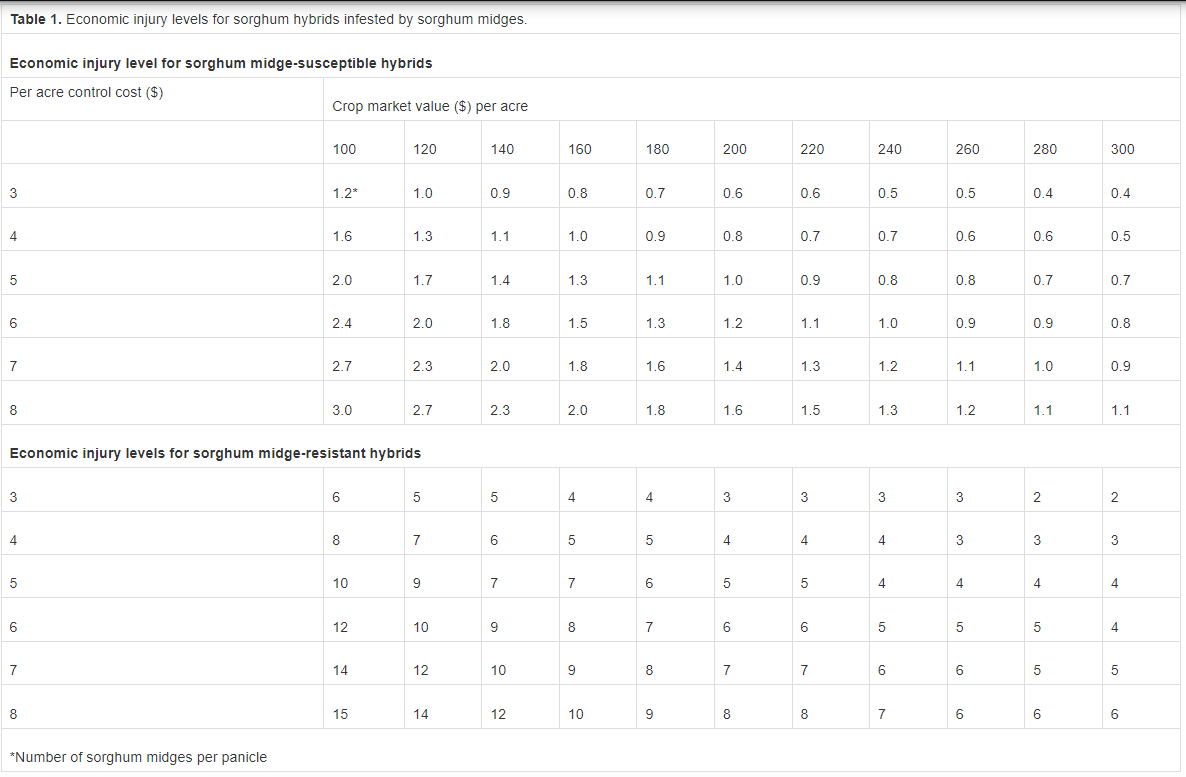
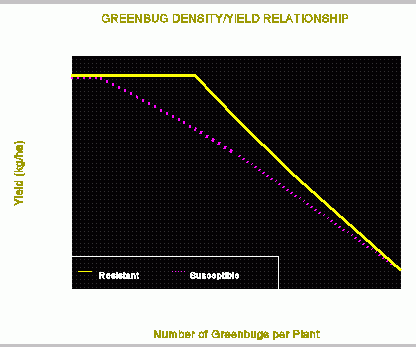
Unfortunately, numerous greenbug biotypes have occurred. As used here, biotype refers to individuals or populations that differ from others based on criteria other than morphology, such as parasitic (virulence) ability. Greenbug biotypes, as I am using the term, are characterized on the basis of differential host plant response within the greenbug species. Currently, 11 biotypes of greenbug have been identified although only biotypes C, E, I, and K are virulent on sorghum in nature. The importance of biotype K is yet to be determined. Despite the consistent occurrence of greenbug biotypes, greenbug-resistant sorghums have been a major component of sorghum IPM. The effect of using greenbug-resistant sorghums on reducing insecticide use is shown in the following figure.
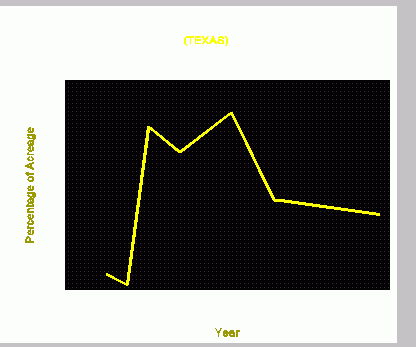
Future Possibilities: Much interest in biotechnology relative to developing insect-resistant plants is in methods known collectively as genetic transformation, rDNA methods, or genetic engineering. These methods enable transfer of a resistance gene that could not be transferred by traditional sexual hybridization. As important, however, are evolving molecular genetic techniques that are providing exciting opportunities to better understand the genetic relationship between an insect and a resistant plant. DNA marker technology is currently used to map and identify specific gene structures conferring resistance traits in plants. Understanding the genetics of resistance in plants will provide the knowledge to improve resistance deployment strategies. However, it is becoming evident with regard to plant resistance to insects that it is equally, if not more, important to understand the genetics of the insect attacking the plant. However, regardless of the technology used to develop insect-resistant plants, the technology will have to be used as a component of IPM in the same way traditionally developed insect-resistant plants are used today.
As new technology has begun to be used, there is increasing concern over the likelihood of formation of insect pest biotypes that can overcome resistance. Many factors are associated with the ability of an insect to overcome plant resistance. A popular theory is that resistant plants exert selective pressure for virulent individuals that become predominant types (biotypes). This theory of biotype selection often is related to theories of evolutionary biology. For example, one evolutionary biology theory is that selection by insects causes plant populations to acquire resistance traits, and selection imposed by these resistance traits gives the insect the ability to exploit these plants. The implication is that insects with a long-term association with a host-plant species have the genetic plasticity to overcome defense strategies of the host plant. That is, resistance in plants that evolved with an insect could be susceptible to being overcome by genetic changes in the insect pest.
Theories on gene conservation and management are major subjects of scientific discussion and experimentation. Strategies for preservation of insect resistance in crop varieties include use of multiple resistance genes conferring different causes of resistance, sequential (time and space) deployment of resistance, and maintenance of refugia to support avirulent individuals to mate with virulent individuals in the insect population. Concern over insect biotypes probably will result in much wiser use of genetic opportunities that now are available or will be available in the future. A major mistake would be to attempt to use gene-altered plants as the sole control tactic for an insect pest rather than a component of IPM. To do so would be to repeat the mistakes of the insecticide era.